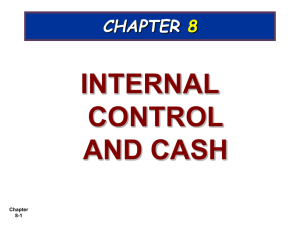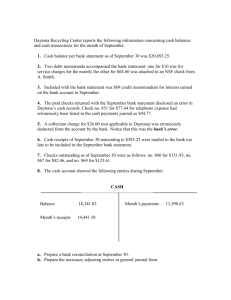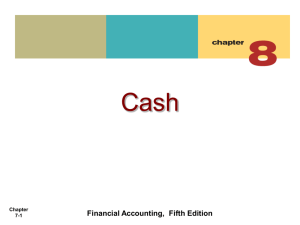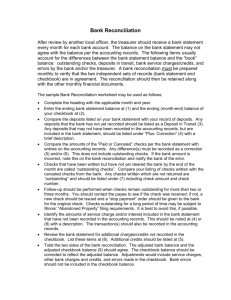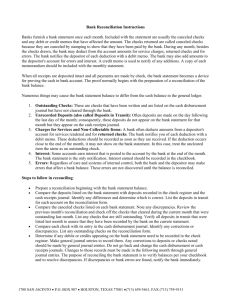bank
advertisement
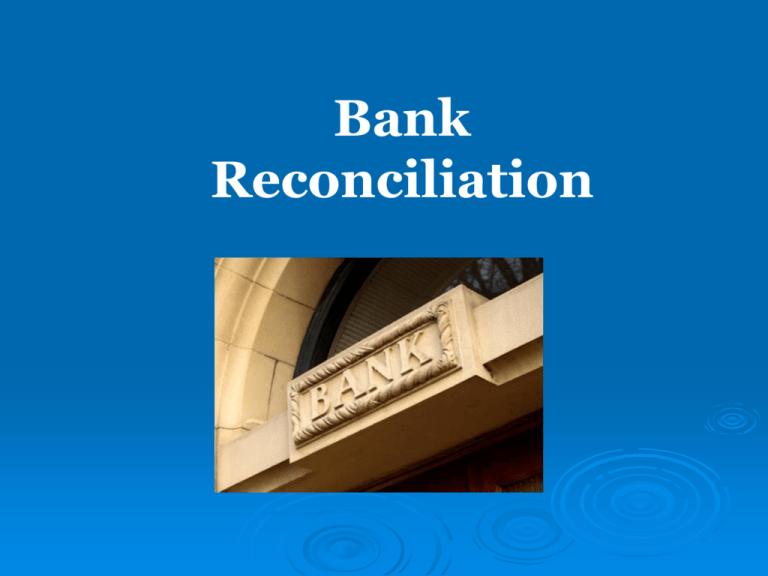
Bank Reconciliation company's general ledger account Cash contains a record of the transactions (checks written, receipts from customers, etc.) that involve its checking account. The bank also creates a record of the company's checking account when it processes the company's checks, deposits, service charges, and other items. A Soon after each month ends the bank usually mails a bank statement to the company. The bank statement lists the activity in the bank account during the recent month as well as the balance in the bank account. When the company receives its bank statement, the company should verify that the amounts on the bank statement are consistent or compatible with the amounts in the company's Cash account in its general ledger and vice versa. This process of confirming the amounts is referred to as reconciling the bank statement, bank statement reconciliation, bank reconciliation, or doing a "bank rec." The benefit of reconciling the bank statement is knowing that the amount of Cash reported by the company (company's books) is consistent with the amount of cash shown in the bank's records. Because most companies write hundreds of checks each month and make many deposits, reconciling the amounts on the company's books with the amounts on the bank statement can be time consuming. The process is complicated because some items appear in the company's Cash account in one month, but appear on the bank statement in a different month. For example, checks written near the end of August are deducted immediately on the company's books, but those checks will likely clear the bank account in early September. Sometimes the bank decreases the company's bank account without informing the company of the amount. For example, a bank service charge might be deducted on the bank statement on August 31, but the company will not learn of the amount until the company receives the bank statement in early September. From these two examples, you can understand why there will likely be a difference in the balance on the bank statement vs. the balance in the Cash account on the company's books. It is also possible (perhaps likely) that neither balance is the true balance. Both balances may need adjustment in order to report the true amount of cash. After you adjust the balance per bank to be the true balance and after you adjust the balance per books to also be the same true balance, you have reconciled the bank statement. Most accountants would simply say that you have done the bank reconciliation or the bank rec. Bank Reconciliation Process Step 1. Adjusting the Balance per Bank We will demonstrate the bank reconciliation process in several steps. The first step is to adjust the balance on the bank statement to the true, adjusted, or corrected balance. The items necessary for this step are listed in the following schedule: St ep 1. Balance per Bank Statement on Aug. 31, 2009 Adjustments: Add: Deposits in transit Deduct: Outstanding checks Add or Deduct: Bank errors Adjusted/Corrected Balance per Bank Deposits in transit are amounts already received and recorded by the company, but are not yet recorded by the bank. For example, a retail store deposits its cash receipts of August 31 into the bank's night depository at 10:00 p.m. on August 31. The bank will process this deposit on the morning of September 1. As of August 31 (the bank statement date) this is a deposit in transit. Because deposits in transit are already included in the company's Cash account, there is no need to adjust the company's records. However, deposits in transit are not yet on the bank statement. Therefore, they need to be listed on the bank reconciliation as an increase to the balance per bank in order to report the true amount of cash. A helpful rule of thumb is "put it where it isn't." A deposit in transit is on the company's books, but it isn't on the bank statement. Put it where it isn't: as an adjustment to the balance on the bank statement. Outstanding checks are checks that have been written and recorded in the company's Cash account, but have not yet cleared the bank account. Checks written during the last few days of the month plus a few older checks are likely to be among the outstanding checks. Because all checks that have been written are immediately recorded in the company's Cash account, there is no need to adjust the company's records for the outstanding checks. However, the outstanding checks have not yet reached the bank and the bank statement. Therefore, outstanding checks are listed on the bank reconciliation as a decrease in the balance per bank. Recall the helpful tip "put it where it isn't." An outstanding check is on the company's books, but it isn't on the bank statement. Put it where it isn't: as an adjustment to the balance on the bank statement. Bank errors are mistakes made by the bank. Bank errors could include the bank recording an incorrect amount, entering an amount that does not belong on a company's bank statement, or omitting an amount from a company's bank statement. The company should notify the bank of its errors. Depending on the error, the correction could increase or decrease the balance shown on the bank statement. (Since the company did not make the error, the company's records are not changed.) Step 2. Adjusting the Balance per Books The second step of the bank reconciliation is to adjust the balance in the company's Cash account so that it is the true, adjusted, or corrected balance. Examples of the items involved are shown in the following schedule: St e p 2. Balance per Books on Aug. 31, 2009 Adjustments: Deduct: Bank service charges Deduct: NSF checks & fees Deduct: Check printing charges Add: Interest earned Add: Notes Receivable collected by bank Add or Deduct: Errors in company's Cash account Adjusted/Corrected Balance per Books Bank service charges are fees deducted from the bank statement for the bank's processing of the checking account activity (accepting deposits, posting checks, mailing the bank statement, etc.) Other types of bank service charges include the fee charged when a company overdraws its checking account and the bank fee for processing a stop payment order on a company's check. The bank might deduct these charges or fees on the bank statement without notifying the company. When that occurs the company usually learns of the amounts only after receiving its bank statement. Because the bank service charges have already been deducted on the bank statement, there is no adjustment to the balance per bank. However, the service charges will have to be entered as an adjustment to the company's books. The company's Cash account will need to be decreased by the amount of the service charges. An NSF check is a check that was not honored by the bank of the person or company writing the check because that account did not have a sufficient balance. As a result, the check is returned without being honored or paid. (NSF is the acronym for not sufficient funds. Often the bank describes the returned check as a return item. Others refer to the NSF check as a "rubber check" because the check "bounced" back from the bank on which it was written.) When the NSF check comes back to the bank in which it was deposited, the bank will decrease the checking account of the company that had deposited the check. The amount charged will be the amount of the check plus a bank fee . Because the NSF check and the related bank fee have already been deducted on the bank statement, there is no need to adjust the balance per the bank. However, if the company has not yet decreased its Cash account balance for the returned check and the bank fee, the company must decrease the balance per books in order to reconcile. Because the check printing charges have already been deducted on the bank statement, there is no adjustment to the balance per bank. However, the check printing charges need to be an adjustment on the company's books. They will be a deduction to the company's Cash account. Interest earned will appear on the bank statement when a bank gives a company interest on its account balances. The amount is added to the checking account balance and is automatically on the bank statement. Hence there is no need to adjust the balance per the bank statement. However, the amount of interest earned will increase the balance in the company's Cash account on its books. Notes Receivable are assets of a company. When notes come due, the company might ask its bank to collect the notes receivable. For this service the bank will charge a fee. The bank will increase the company's checking account for the amount it collected (principal and interest) and will decrease the account by the collection fee it charges.Since these amounts are already on the bank statement, the company must be certain that the amounts appear on the company's books in its Cash account. Errors in the company's Cash account result from the company entering an incorrect amount, entering a transaction that does not belong in the account, or omitting a transaction that should be in the account. Since the company made these errors, the correction of the error will be either an increase or a decrease to the balance in the Cash account on the company's books. Step 3. Comparing the Adjusted Balances After adjusting the balance per bank (Step 1) and after adjusting the balance per books (Step 2), the two adjusted amounts should be equal. If they are not equal, you must repeat the process until the balances are identical. The balances should be the true, correct amount of cash as of the date of the bank reconciliation. Step 4. Preparing Journal Entries Journal entries must be prepared for the adjustments to the balance per books (Step 2). Adjustments to increase the cash balance will require a journal entry that debits Cash and credits another account. Adjustments to decrease the cash balance will require a credit to Cash and a debit to another account. Powered by Feed Informer Sample Bank Reconciliation With Amounts In this part we will provide you with a sample bank reconciliation including the required journal entries. We will assume that a company has the following items:

